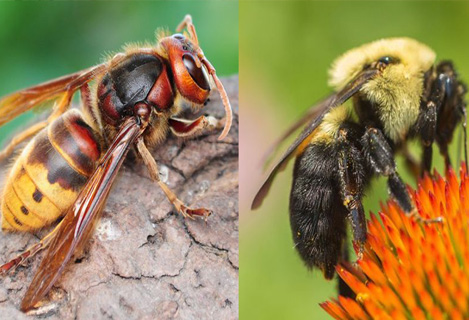
Their sting hurt and a bee or wasp sting can become life threatening at times.Nothing ruins a good barbecue like a swarm of wasps buzzing around, making your guests uncomfortable and scared!
The general rule is to stay calm because these pests aren’t aggressive unless they are provoked, but often that is easier said then done. It’s hard not to flap our arms around and swat at bees and wasps when they are buzzing around us!
Native Bees
There are over 2000 species of bees native to Australia of which hundreds occur in Australia.
Sizes range from 2mm to 25mm.
Large variation in colour.
Some are hairy and others are bare.
Hairy bees carry pollen in special hairs on the hind legs.
Hairless bees swallow the pollen mixed with nectar.
Most native bees are solitary. Each female constructs its own nest. Some nest in the ground, others in cavities.
Most females have a sting but none are aggressive.
Males play no part in nest construction but only search for and fertilise the female.
Honeybees
Honeybees often break away from the commercial hives and establish themselves in areas, which cause danger and concern to man.
Treatment may be required where bees cannot be removed in places such as cavity walls.
There are few safe to use registered chemicals for bees.
Care must be taken when destroying a hive.Bees may become aggressive and attack passers by and the operator.
Removing honey bee nests from cavities (walls of houses, hollow trees) is a time-consuming, labour-intensive practice that should be undertaken by professionals. Continuous honey bee flight activity to and from a hole in a building is an indication of a nest. Many times, this can be confirmed by listening for bees buzzing inside.
An experienced beekeeper usually can remove bees and combs from easily accessible places like hollow trees, but often bees live in building walls or are tucked away where they are impossible to reach.
Simply killing bees in a cavity with an insecticide can have serious consequences:
Dead bees and dead brood will decay and produce strong odours.
Stored honey can absorb moisture and ferment or overheat without adult bees to tend it. This results in burst cappings, producing leaking honey from combs which can penetrate ceilings or walls, causing stains, sticky puddles around doors and windows, and softening of gyprock walls.
The quickest way to remove bees from buildings is to kill them and remove all traces of the nest. In most cases an inner wall or ceiling must be removed, however, calling for the services of a building contractor. It is essential to remove all honeycombs and to plug all holes to be certain there is no way for bees to re-enter the area. Any remaining bits of bees wax emit highly attractive odours to swarming bees.
There are a number of ways to kill bees. It is important to exterminate a colony when all bees are on the nest (dusk or dawn). This reduces the number that might be in the field and return to cause problems. Many persons use commercially available wasp and hornet spray for killing the bees. This knocks down the insects quickly and can be used from a distance. Dust formulations of labelled pesticides may also be pumped onto an enclosed nest. There is more and more evidence that soapy water is also a very good material to use that is inexpensive and relatively environmentally benign. How the bees are killed will depend on the particular situation. A slower method of honeybee removal, which kills fewer of the insects, can be used in certain situations. It is based on the principle that bees that leave a building can be prevented from re-entering. However, the bees will cluster in a large mass around their previous exit where they are encouraged to enter another colony. Experienced beekeepers do the job best; they are used to bees flying around and to being stung occasionally. The following steps are recommended:
Fold a piece of window screen to make a cone wide enough at the bottom to completely cover the bees’ entrance to the building. This cone is then reduced to about 3/8 inch in diameter. Bend the cone’s smaller opening upward.
Plug all other holes where bees may enter the building. This is the key to any removal process. All other bee exits must be sealed!
Protect yourself with at least a bee veil and long sleeves (bee gloves are optional) and use a smoker to confuse the bees. Fasten the large end of the screen cone tightly over the entrance.
Position the one-storey hive as near the cone entrance as possible. It can be positioned on brackets nailed to the building. Place the frames with brood and honey in the centre of the hive; place frames of drawn comb or foundation at the sides. The hive entrance should be reduced to about a 1-inch opening to protect the colony from being robbed by stronger colonies that may be in the area. Bees emerging from the screen cone will not be able to find their way back into the building. Instead, they enter the hive. As bees leave the building and move into the hive, the old colony will grow weak.
About 4 weeks later, remove the cone. Bees from the new hive will now be able to enter the building (their previous nest) and transfer the honey to the new hive. The queen in the building is lost along with a few other bees and perhaps some brood. However, with all the honey removed, there is little possibility of major odour or honey leakage problems. After the bees have moved completely and the honey has been transferred, close all holes and cracks to prevent bees from re-entering.

He is truly passionate about his work and offers honest advice. He is also extremely respectful of other people's property. All of these qualities are very rare nowadays so I will definitely be using his services annually. Thanks

He was very professional and he also adviced us on our pool gate that was not in working order that we did not know about we have two young children and this was not part of his job so this really impressed us. Thank you Sonny

Fantastic service with Immediate results. You won't be disappointed. He was very friendly, informative & did an awesome job today. I'll recommend Sydney's with pest away pest control to everyone I know. Thank You ?

I have done a pest control with pest away pest control. It is very worthwhile, reliable and the person who came (Mr Omar) to do the job is very friendly and did the job very well. I recommend this company to any body who want to do a good job and worth for the money you are paying.

A knowledgable, friendly and efficient service with pest away pest control. It's so refreshing to get an honest appraisal rather than one that is only based on profit. We will definitely use them again.

Pestawaypestcontrol is one of the most helpful and supportive professionals I have ever met. He will go out of his way to assist you and ensure you receive the best advice regarding the most effective pest control methods available. I would thoroughly recommend Sydneys Pest Control without hesitation.

He was very professional and he also adviced us on our pool gate that was not in working order that we did not know about we have two young children and this was not part of his job so this really impressed us. Thank you Sonny

A company offering free advice, without pushing for business, is very refreshing. After examining photos of a pest problem I was experiencing, Pest away pest control , phoned me to discuss the matter. His advice was to take my photos to my local hardware store to obtain the correct product to treat the problem myself. There was no pressure to use the services of his company. I was very impressed with knowledge and professionalism. After this experience, I would certainly use the company for my annual pest control treatment.

He is truly passionate about his work and offers honest advice. He is also extremely respectful of other people's property. All of these qualities are very rare nowadays so I will definitely be using his services annually. Thanks
